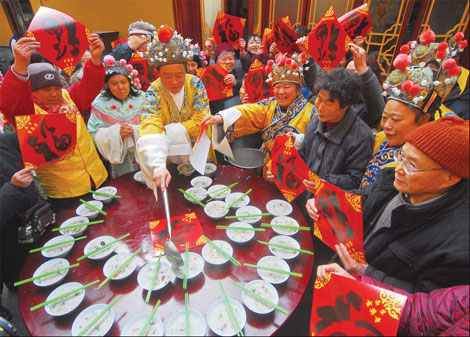Begin with laba
Updated: 2012-01-06 08:01
By Hu Yijun (胡逸君) (China Daily)
|
||||||||
|
Chinese people celebrate the Laba Festival in Nanjing by sharing Laba rice porridge. [Shao Dan / For China Daily] |
Chinese people start their preparations for the Spring Festival more than 20 days early. this year, It all started with Laba, on Jan 1
Chinese people start their preparations for the Spring Festival more than 20 days early. The 12th lunar month in Chinese is called La Yue (腊月 là yuè), so the eighth day of this lunar month is La Yue Chu Ba (腊月初八 là yùe chū bā), or Laba (腊八 là bā). The day is also known as the Laba Rice Porridge Festival. The Laba this year was Jan 1 - or New Year's Day.
The three major customs on Laba are ancestor worship, eating Laba rice porridge (腊八粥 là bā zhōu) and making Laba garlic.
Ancestor worship (祭祖 jì zǔ): At the end of the year, working people get more free time to prepare for the sacrifice to the ancestors. The reason the 12th lunar month is called La Yue has a lot to do with the custom of sacrifice.
First, the worship of ancestors, called "腊" in Chinese, and the sacrifice for the gods, called "蜡 (là)", both frequently took place in the 12th month, which led to the traditional name of the month: La Yue (腊月).
Second, winter is the slack season for farmers so they have time to find things to burn in the sacrifice. The radical of "腊" represents the sacrifice of meat to one's ancestors ("月" symbolizes meat).
Laba rice porridge: There are several legends about the origin of porridge eating on Laba: Some claim it is of Buddhist origin; some say the porridge, made of red beans, can exorcize evil from children. Others say the porridge is in memory of a poor couple.
The custom of porridge eating has been well known throughout history, from the royal court to common people.
The most "authentic" porridge was made in northern China, especially Beiping (北平).
The main ingredients of the Laba porridge are rice and sticky rice; people also add sugar, red dates, lotus seeds, walnuts, chestnuts, almonds, longans, hazelnuts, raisins, red beans, peanuts, water caltrops, roseleaf and other various materials to make the porridge special.
Almost every part of China has its own local recipe for the Laba porridge. Eating hot porridge is great in cold winter, and the grain and nuts are considered healthy winter fare.
Laba garlic (腊八蒜 là bā suàn): It is an old Beijing custom to soak purple-peel garlic with vinegar and a little sugar.
First, pare the old skin of the garlic, then put the vinegar and garlic into a jar and seal it for keeping until the eve of the Spring Festival.
When the whole family gets together for the dumpling feast that evening, they take out the Laba garlic which will be crisp, with a vinegary flavor and a green color. Vinegar with the aroma of garlic is the best seasoning for dumplings.
Stories are courtesy of The World of Chinese, www.theworldofchinese.com

 Relief reaches isolated village
Relief reaches isolated village
 Rainfall poses new threats to quake-hit region
Rainfall poses new threats to quake-hit region
 Funerals begin for Boston bombing victims
Funerals begin for Boston bombing victims
 Quake takeaway from China's Air Force
Quake takeaway from China's Air Force
 Obama celebrates young inventors at science fair
Obama celebrates young inventors at science fair
 Earth Day marked around the world
Earth Day marked around the world
 Volunteer team helping students find sense of normalcy
Volunteer team helping students find sense of normalcy
 Ethnic groups quick to join rescue efforts
Ethnic groups quick to join rescue efforts
Most Viewed
Editor's Picks

|

|

|

|

|

|
Today's Top News
Chinese fleet drives out Japan's boats from Diaoyu
Health new priority for quake zone
Inspired by Guan, more Chinese pick up golf
Russia criticizes US reports on human rights
China, ROK criticize visits to shrine
Sino-US shared interests emphasized
China 'aims to share its dream with world'
Chinese president appoints 5 new ambassadors
US Weekly

|

|







